For some strange reason, as yet unfathomed by me, I can receive email, but I can’t send any out. I’m going to need the help of a computer guru who knows a lot more than I. Nothing that affects the blog, though, that I know of.
March 2022
Fri 11 Mar 2022
Thu 10 Mar 2022
Reviewed by Dan Stumpf: JEROME WEIDMAN – I’ll Never Go There Any More.
Posted by Steve under Reviews[14] Comments
JEROME WEIDMAN – I’ll Never Go There Any More. Simon & Schuster, hardcover, 1941. Reprinted in paperback several times, including Avon T-153, 1956, shown below:

Two Summers and a lifetime ago, I picked up a novel at a Used Book Store just to be polite; I wasn’t really looking for it, but it seemed interesting and the shopkeeper looked bored, so I figured to brighten her day for two dollars and fifty cents.
The book was I’ll Never Go There Any More, by Jerome Weidman, and it’s a young-man-in-New-York novel, a colorful, sprawling thing about Arthur Thacker coming to the big city, meeting lots of colorful, sprawling people, and learning about Life in all its sprawling color.
And it ain’t bad, either. The characters are well-drawn, the story moves apace, and the ending seems fateful and natural, profound and shocking, all at once, just the right coda for a young-man-in-New York novel. It looks to have been published just before America entered World War II, which is probably why it isn’t better remembered today – after December 7, readers had a lot more on their minds than the adventures of a young man in New York.
But as I was reading this thing, getting the background on the various characters popping in and out, I came upon six or eight pages that seemed kind of familiar: something about an Italian banker and his sons, and how they all turned out. Damn, it just kept reminding me of something.
So I did some research and found that this was the basis of Joseph Mankiewicz’s 1949 movie House of Strangers. Not the book: just these six or eight pages. That’s right, Twentieth Century Fox bought I’ll Never Go There Any More, tossed out three hundred and thirty pages of it, and filmed what was left. House of Strangers is an okay noir drama, but I always felt it lacked a proper pay-off at the end, and it’s certainly very far removed from Weidman’s novel.
But that’s not the end of our story. No, friends. Because in 1954 the studio did what studios always did in those days: they took the script of House of Strangers, added some guns and horses and re-made it as Broken Lance. And that’s how Jerome Weidman’s young-man-in-New-York novel ended up as a Western.
Wed 9 Mar 2022
A Western Movie Review by David Vineyard: BROKEN LANCE (1954).
Posted by Steve under Reviews , Western movies[12] Comments

BROKEN LANCE. 20th Century Fox, 1954. Spencer Tracy, Robert Wagner, Jean Peters, Richard Widmark, Katy Jurado, Eduard Franz, Hugh O’Brian, E. G. Marshall, Earl Holliman, Carl Benton Reid. Screenplay by Richard Murphy based on the screenplay for House of Strangers by Philip Yordan. Director: Edward Dmytryk.
By 1954 when this drama of a family in conflict and brothers at each others throats was made, the Western was the dominant form of entertainment in theaters around the country, and the simple morality plays of an earlier era had been replaced with far more complex and adult themes. Novels, histories, and original screenplays were being churned out in great number and it was perhaps natural that Hollywood would turn to its own products for the basis of new material for the seemingly endless demand for new Westerns.
It had already begun in the Post War-era. Raoul Walsh remade his own High Sierra as Colorado Territory, John Ford’s Four Men and a Prayer was remade as Fury at Furnace Creek, Kiss of Death as The Fiend Who Walked the West, Objective Burma as Distant Drums, and soon Asphalt Jungle as Badlanders, The Lost Patrol as The Last of the Comanches, even Gunga Din as Sergeants 3.
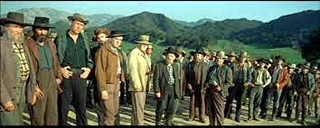
Broken Lance was a remake of Joseph L. Mankiewicz’s 1949 film noir House of Strangers. In that one Edward G. Robinson was the patriarch of an Italian banking family whose favorite son, Richard Conte who loves society woman Susan Hayward, goes to jail to save the old man when he gets in trouble with his high-handed ways only to find his brothers led by Luther Adler out to destroy him and cheat him out of his part of the family fortune when he finishes his prison term.
Here Spencer Tracy is Matt Devereaux, cattle rancher and pioneer who has died while his youngest son Joseph (Robert Wagner) was in prison. Joe’s half brothers Ben, Mike, and Denny (Richard Widmark, Hugh O’Brian, and Earl Holliman Jr.) try to buy him out and send him packing when Joe is released, but Joe still has business and memories to deal with.
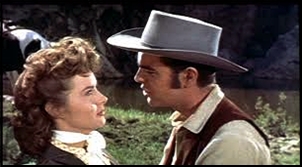
The movie opens with a lobo wolf running wild across the landscape. We will later see Matt refuse to let son Denny shoot the same wolf, and at one point Matt’s Native American foreman (Eudard Franz) tells Joseph that Matt’s spirit runs with the wolves. We see and hear the wolf a final time as the music rises and The End appears hammering home the theme.
The story is told in flashback, and to Mankiewicz’s plot, Dmytryk and screenwriter Richard Murphy add a sub plot about racism and intolerance since Wagner’s Mother (Katy Jurado, who was only six years older than Wagner) is Native American, a source of many not so subtle snubs from Matt’s business partners..
When Old Matt takes on a copper mine poisoning his source of water and destroys the place he finds his friend the territorial governor (E. G. Marshall — and yes the film several times refers to Arizona as a state well before that happened) is unwilling to help him unless he stops Joe from romancing his daughter Barbara (Jean Peters).
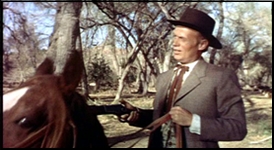
The legal proceedings go badly and Joe volunteers to go to prison to save his father striking a deal to only serve a short sentence if Matt will sell the land to the copper interests, but when the time comes older brother Ben refuses to sign, Joe is sent to prison for three years, and Matt has a stroke confronted by Ben and his brothers refusal to help Joe.
While Joe is in prison the brothers undo everything Old Matt built and eventually cause his death in a well done scene reminiscent of the end of El Cid. But Joe wants no part of fratricide having said his goodbyes to his dead father and is ready to leave when Ben decides he would never sleep well as long as Joe was alive and decides to kill him.
Beautifully shot by cinematographer Joe MacDonald, with a strong score by Leigh Harline, and imaginatively staged by director Edward Dmytryk, Broken Lance is a satisfying adult Western with the shoot ’em up action nicely balanced by family drama, a trial, and Tracy in larger than life scene stealing mode (there are two life sized portraits of Tracy featured in the film I would kill to own).
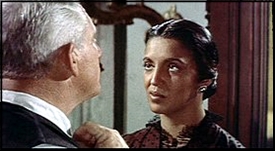
An avid polo player when he was younger Tracy sits a horse well and looks natural in the saddle. At this point he was still active enough to look believable in action scenes.
Widmark is good (when isn’t he?) as Ben the resentful older brother who hates his father enough to destroy every thing and everyone around him including his half brother. O’Brian and Holliman fill out the roles of the two wastrel middle brother well enough though neither has much to do.
Of course Katy Jurado is fine in anything she plays and in this period has one fine role after another. Eduard Franz plays Old Matt’s Native foreman and surrogate father to Wagner’s character with his usual quiet efficiency (he plays a similar role as a tracker in The Burning Hills). Peters, Marshall, Reid are all solid in their various supporting bits as well.
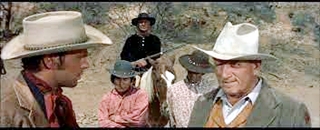
The star here though, despite Tracy’s top billing, is Wagner, who is in almost every scene as the decent loyal son, and holds his own opposite the likes of Tracy (Wagner knew many of the Old Hollywood elites well, including Tracy who he had caddied for when he was younger) and Widmark. He played opposite O’Brian in The White Feather, so this was old home week in some ways.
It’s no easy task for a young actor to even stay on the screen with the likes of Tracy (they played brothers in The Mountain) and Widmark, but he does it with ease. He was always at ease on screen, perhaps too much so for his own growth as an actor, but here he more than manages the unenviable trick of having to hold the screen when viewers are waiting for more of Tracy and Widmark.
Incidentally there is a quiet scene with Tracy and Widmark that is almost a masterclass in two screen naturals subtly battling for screen dominance and coming to a draw without either of them ever once slipping out of character or crossing the obvious line into scene stealing. Widmark’s quiet self assurance on screen with Tracy, expressed in his relaxed posture, even adds to the tension between their characters in the film.
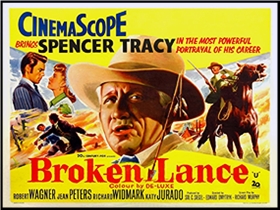
Tue 8 Mar 2022
Reviewed by Tony Baer: SHIRLEY JACKSON – The Haunting of Hill House.
Posted by Steve under Reviews[11] Comments
SHIRLEY JACKSON – The Haunting of Hill House. Viking, hardcover, 1959. Popular Library, paperback, 1962. Reprinted many times. Film#1: Argyle, 1963, as The Haunting (director: Robert Wise). Film #2: DreamWorks, 1999, as The Haunting (director: Jan de Bont).

Eleanor is lonely. Very, very lonely.
A 30ish shy caretaker for her now dead mother, she lets a room in her sister’s house.
Lucky her, she sees an ad. A professor is looking for volunteers to spend the summer at a well-known supposedly ‘haunted house’ to research psychic phenomena and prove the existence of the paranormal. Room and board included.
Eleanor’s got nothing better to do. So writes back to the PO Box, steals her sister’s car and drives out to the house.
There’s a group of four: Professor, Eleanor, another unattached young woman, and Luke, an eligible bachelor who stands to inherit the estate.
The house is labyrinth. Lots of doors and halls and connected rooms, many without windows. It’s nearly impossible to navigate. It’s dark. The heavy doors won’t stay open.
Inexplicable noises appear in the night. The doors shake. They’re coming for me. I should let myself go. Then they’ll leave you alone, Eleanor says to the others. They’re only after me.
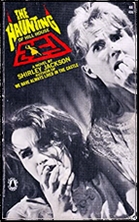
One night, Eleanor’s name is found written on a wall. Urging her to come home. Maybe she wrote it herself.
But I have no home, says Eleanor.
This is my home.
The home wants me here.
Eleanor begins to believe, more and more, that she belongs. Finally, she belongs. She must stay here forever.
Her erratic behavior is interfering with the Professor’s investigations. She’s becoming very annoying to the others. They ask her to leave.
But she can’t.
___
Can’t say I loved it. It was okay. A bit of a slog. And, in a haunted sense, nothing much happens. On the other hand, the subtlety of the haunting, the blurring of ghosts and schizophrenia, makes it more believable. I guess if it wasn’t called “The Haunting of Hill House†and was just called “Eleanor Goes Insane,†I’d have liked it more.
Now have read both this and We Have Always Lived in the Castle, which I prefer. It is about 2 eccentric lonely sisters in a dilapidated old mansion at the center for a conservative little town. One is a beautiful and waifish maiden, thought by all to have been the murderess of the remainder of their family. The other, an ugly, impish creature, thought to be dumb, but with a hateful, plotting mind. I suppose I like it more because I believe in insanity more than I believe in ghosts.
Mon 7 Mar 2022
A 1001 Midnights Review: RAOLD DAHL – Someone Like You.
Posted by Steve under 1001 Midnights , Reviews[3] Comments
by Marcia Muller
RAOLD DAHL – Someone Like You. Alfred A. Knopf, hardcover, 1953. Dell #F139, paperback, 1961. Reprinted many times.

Roald Dahl’s short stories have been called-among other things — bizarre, comic, horrific, clever, and playful. Dahl depicts a world where things are a little — or sometimes a lot — skewed from the world we know, and the events he chronicles often produce wrenching horror in his reader. But he has also been known to inject a comic twist into his stories, and he toys with the reader, teasing the story line along like a mischievous child until he has us completely fooled.
Perhaps his most famous story is “Lamb to the Slaughter.” It begins on a deceptively quiet note, with Mary Maloney waiting in her cozy parlor for her husband to come home from work. Mary is a devoted housewife, six months pregnant, and she takes excellent care of her policeman husband, but tonight she has neglected to take anything out of the freezer. And when she does, after her husband makes a startling announcement, a leg of lamb seems quite appropriate …..

“Taste” likewise deals with food. Mike Schofield, a London epicure, is giving a dinner party to which he has invited a famous gourmet. Mike is proud of his wine cellar and anxious to trip up his guest on his knowledge of fine but obscure vintages. In fact, he is so sure of his ability to do so that he makes a most dangerous wager.
These first two stories are examples of Dahl’s lighter work. On the more serious side is “Man from the South,” which concerns a different, more deadly wager. In “The Soldier,” Dahl makes a subtle statement about the aftermath of war. And readers and writers alike will be both amused and shaken at the implications of “The Great Automatic Grammatisator.”
This collection shows Dahl at his best. Other volumes of his varied and multifaceted short stories include Kiss, Kiss (1960), The Best of Roald Dahl ( 1978), and Tales of the Unexpected (1979). In addition, he has written two novels: Sometime Never: A Fable for Supermen (1948) and My Uncle Oswald (1979).
———
Reprinted with permission from 1001 Midnights, edited by Bill Pronzini & Marcia Muller and published by The Battered Silicon Dispatch Box, 2007. Copyright © 1986, 2007 by the Pronzini-Muller Family Trust.
Mon 7 Mar 2022
“To be or not to be: that is the question, whether tis nobler in the mind to suffer the slings and arrows of outrageous fortune.”
=
“In one of the Bard’s best-thought-of tragedies, our insistent hero, Hamlet, queries on two fronts about how life turns rotten.”
Sun 6 Mar 2022
Reviewed by Dan Stumpf: AMOR TOWLES – A Gentleman in Moscow.
Posted by Steve under Reviews[3] Comments
AMOR TOWLES – A Gentleman in Moscow. Viking, hardcover, 2016. Penguin Books, softcover, 2019.
I just spent two pleasant weeks in the company of Count Alexander Ilyich Rostov, and feel duty-bound to recommend in the most glowing possible terms that the readers out there avail themselves of his companionship. He can be found at the Metropol Hotel, in (where else?) Moscow, anytime between 1922 and 1956.
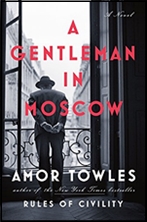
The count is thus so readily and consistently available owing to the fact that in the first chapter he is tried by the Emergency Committee of the People’s Commissariat for Internal Affairs (This is in 1922, when the Revolution was still fresh) and sentenced to Life under House Arrest. Since he’s been living at Moscow’s luxurious Hotel Metropol, that would seem none too bad, but he’s unceremoniously moved from his regal suite to a tiny room in the belfry, barely large enough to stand upright and move around in, which will be home base in his hotel-world for the next thirty years. Nothing daunted, Rostov sets about turning his gilded cage into a vantage point from which to see and savor Life.
The novel that ensues from this premise is four-hundred-and-some-pages of pure pleasure, mostly because Towles writes like a man who enjoys writing, and conveys that joy with vivid descriptions of food, drink, rare warm days, starry Moscow nights, beautiful women, good movies (He even picks out a moment in Casablanca I never noticed!) good deeds done by important people, and great things done by good people.
Don’t get the notion, though, that this is Rebecca of Metropol Hotel. Towles takes us through the idealism and chaos of the Bolsheviks, to Stalin’s genocidal reign, Hitler’s invasion, and the ascent of Khrushchev. And he conveys the lethal idiocy of bureaucracy to chilling effect, as some of those nearest to Rostov find their life’s work — and their lives — tossed aside by the arrogance of the genuinely stupid.
A Gentleman in Moscow is a complex and richly varied work, even one that requires some effort from the reader. But it rewards the effort with characters who come alive on the page, and with a tale you won’t forget.
Sat 5 Mar 2022
A Movie Review by David Vineyard: PACIFIC BLACKOUT (1941).
Posted by Steve under Action Adventure movies , Reviews[5] Comments
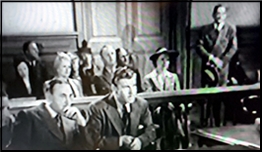
PACIFIC BLACKOUT. Paramount Pictures, 1941. Robert Preston, Martha O’Driscoll, Philip Merrivale, Eva Gabor, Louis Jean Heydt, Thurston Hall, J. Edward Bromberg, Mary Treen, Monte Blue, Rod Cameron. Screenplay: Lester Cole & W. P. Lipscomb. Story by Franz Spencer (Franz Schulz) & Curt Siodmak. Directed by Ralph Murphy.
As Seattle prepares for its first city wide blackout of the pre-War era replete with the Army providing bombers to drop faux weapons, Robert Draper (Robert Preston), a young inventor who has been working on range finder for the Army, is on trial for murdering his partner, and it looks bad for him, what with French nightclub singer Marie Duval (Eva Gabor) swearing he is guilty, though he swears he never met her.
John Runnel (Philip Merrivale), an expert on blackouts, is advising the city and a friend of Draper’s, but there is nothing he can do when Draper is convicted and sentenced to death (they move fast in B -movies).
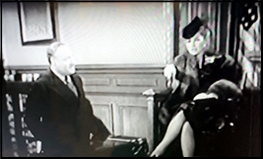
While being transferred to prison that night as the blackout begins, there is an accident and Draper escapes, and while trying to find a way out of his handcuffs, he meets Mary Jones (Martha O’Driscoll), who is walking her dog in the park.
Mary is one of those screwball types you could only find in a movie of this era, and in short order she is helping Preston in his escape through a series of misadventures that fill up most of the movie a la a more urban 39 Steps (one of the most oft repeated plots in Hollywood history, even by Hitchcock).
About midway through, the big secret regarding the villain is revealed, but it isn’t until right at the end we discover the McGuffin: saboteurs have substituted a real bomb for one of the phony ones to be dropped on Seattle by pilot Rod Cameron’s unsuspecting crew.
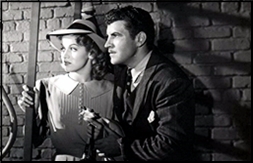
To the extent this works its because of Preston and O’Driscoll, and a decent performance by a young Eva Gabor as the French girl whose testimony has been extorted by the unexpected German spy behind the whole thing. J. Edward Bomberg has a nice bit in a medical treatment shelter as a slight of hand artist turned pick pocket who helps Preston out in a tight.
I’m curious if there ever was a blackout quite as extravagant as this one, but being on the West Coast and knowing Spielberg’s 1941 was loosely based on fact it is just in the realm of possibility (probably not with bombers dropping bags informing kids they have just been killed by poison gas).
This is by turns screwball comedy, spy thriller, murder mystery, and patriotic flag waver, but makes so many sudden turns you may get a little dizzy trying to follow it. It never manages to all come together, but individual bits are worth seeing, and Preston is always good.
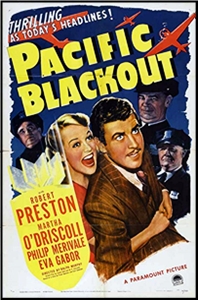
Fri 4 Mar 2022
A TV Episode Review: THE CLOSER “Pilot†(2005).
Posted by Steve under Reviews , TV mysteries[4] Comments
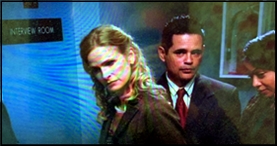
THE CLOSER. “Pilot.†TNT, 13 June 2005 (Season 1, Episode 1). Kyra Sedgwick (Brenda Leigh Johnson), J. K. Simmons (Will Pope), Corey Reynolds, Robert Gossett, and a large ensemble cast. Guest star: Allison Smith. Written by James Duff. Directed by Michael M. Robin. Currently streaming on HBOMax.
One of the bigger hits on cable non-network TV, The Closer was on for seven summers on TNT before transforming itself into Major Crimes, a spinoff which continued on and lasted for another six years. You can’t tell me why I’m so slow, because I don’t know myself, but when I watched this, the pilot for the first season, it was the first episode I’ve ever seen of either series.
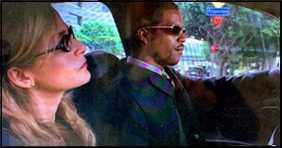
And now I’m kicking myself, as I enjoyed this one immensely. As all good pilots do, it introduces the major players clearly and emphatically, while at the same time telling a good story, one with a bit of a twist at the end. Admittedly we do get to know the lesser members of the ensemble cast only in passing. To all intents and purposes, this is a one-woman show, Kyra Sedgwick as no-nonsense, ass-kicking Brenda Johnson, who is hired from outside to head up LAPD’s Priority Homicide Division.
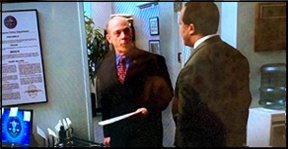
Her blunt personality wins her no friends on the force. Other than Brenda’s new boss, Will Pope, who hired her, all of the others turn in their resignations about 20 minutes into this first episode. I don’t know how long into the season it will take for her to win all of them over for good, but by the time she’s cracked her first case, it appears that she’s received at a small modicum of respect, at least, grudgingly as it may be.
And as far as the case is concerned, when the mutilated and burned body of a woman is found in the home of a high-tech millionaire, who has disappeared. Strangely, none of his fingerprints are in the house, only the victim’s. Brenda’s trademarked final closing scene is what it takes to induce a confession from the killer, an ending that clearly and forcefully delivered, the first of many to come.
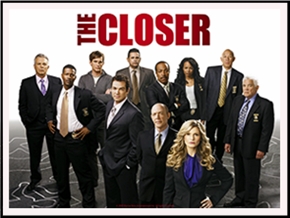
Thu 3 Mar 2022
by Francis M. Nevins
What I’m about to describe sounds like a coincidence worthy of Harry Stephen Keeler, but it really happened. During the year 1928 two young men of New York, working in the advertising and publicity fields, spent most of their evenings, weekends and vacation time collaborating on a detective novel for submission to a writing contest with a $7,500 prize.
Their names were Frederic Dannay and Manfred B. Lee, and the byline they used for their novel was Ellery Queen. They won the contest (only to lose it again, but that’s another story) and eventually became world-famous under that byline.
Many of their subsequent novels and stories centered around a cryptic message left by the murder victim.
Now comes the hard-to-believe part. During that same year 1928 a book was published which consisted of three long stories plus a framing story. The first of the long stories, “The Giant Moth,†was also about two young men in the advertising business who had written a detective novel for a prize competition.
On the eve of the announcement of the winner, one of the two—a fellow named Wilk Casperson who’s desperate to win and use his share of the money to set up housekeeping with the daughter of a wealthy stockbroker—goes to a masquerade ball at the mansion of his girlfriend’s father dressed as, you guessed it, a giant moth, and quickly becomes involved in a murder whose victim apparently left behind him, you guessed it again, a dying message.
Who wrote this story? The King of Koinkydink. The nuttiest filbert of them all. In his middle twenties, after a few years of turning out fairly ordinary short stories, usually with O. Henry twist endings, Harry Stephen Keeler (1890-1967) became more ambitious and, beginning in 1914, concentrated on much longer tales. Usually works of such length are called short novels, novelettes, novelets or novellas. Harry liked to call them novellos, probably with the accent on the first syllable.
“The Giant Moth†first appeared in Top-Notch, 1 June 1918, at about 35,000 words. Ten years later and at least 20,000 words longer, it became the tale of the first prisoner in Keeler’s SING SING NIGHTS (Dutton, 1928).
Fast forward almost a century and it still stands up as a beautiful example of the kind of plot only Keeler could devise. With two characters dressed as moths attending the same masquerade ball at different times, two supplies of disappearing ink, a Chinese gangster who like-a to speak-a in de Italian dialecto, a missing diamond necklace, a murdered lepidopterist, an enigmatic Japanese servant, and a secret map giving away the defenses of the Panama Canal, the story has enough wackadoodle elements for three times its length, but let’s focus on the dying message.
Paralyzed from the waist down after being shot in the back, and with no pen or pencil within reach, the mothologist in his last moments apparently made use of what he did have available—some strips of tissue paper and rubber type used to make out classification cards for his specimens—to leave the following message:
FIND
USHI
HE
KNOWS
Ushi is the name of the moth maven’s servant, who has vanished. No reader in a million years could figure out the real meaning of that message and no writer other than Keeler could have dreamed up the gimmick. Whether Fred Dannay or Manny Lee ever heard of the tale remains unknown.
The Ellery Queen novels and stories proved to be so popular in the 1930s that at the end of the decade a network radio series about the character was launched, with Hugh Marlowe (1911-1982) as EQ. The prime mover behind the series was George Zachary (1911-1964), who served as producer and director from its debut on CBS as an hour-long program (18 June 1939) till its departure in 30-minute form on 22 September 1940.
In January 1942, a month after Pearl Harbor, the series returned on the NBC Red Network, with Carleton Young (1907-1971) as Ellery. Zachary continued as producer but was replaced in his other capacity by two men from the Ruthrauff & Ryan advertising agency’s stable of directors working in alternation, Bruce Kamman and the man we are to follow.
Knowles Entrikin (1880-1956) is almost completely forgotten today, but in his time he was fairly well-known on the stage as a producer, playwright and director before he entered radio. Perhaps his main claim to fame in that medium was that in 1934, as director of the CBS educational series American School of the Air (1930-48), he hired a brash 19-year-old named Orson Welles for his first audio acting job.
I know of only one reference to Entrikin’s work on the EQ series, an unpublished letter of 22 November 1942 from Manny to Fred, discussing the program’s most recent episode (“The Bald-Headed Ghost,†19/21 November):
I take it that the last words mean: Who will know you and I aren’t to blame?
Entrikin seems to have remained with the EQ series from its return to the air in January 1942 until fourteen months later when Ruthrauff & Ryan assigned him to a project on the West Coast. He’s included here because, like Harry Stephen Keeler, he brushed against Fred Dannay and Manny Lee.
Finally we come to another man, infinitely better known than Entrikin, who was thought to have brushed against Fred and Manny but actually didn’t. I refer to none other than John Wayne. During the WWII years the Queen radio series featured Hollywood personalities and some unknowns, many of them in the military, as guest armchair detectives.
My book THE SOUND OF DETECTION: ELLERY QUEEN’S ADVENTURES IN RADIO (2002) included an episode-by-episode list of those guests, based on research in old studio files by Martin Grams, Jr. Much of what Marty found in those files consisted only of guests’ first initials and last names. For “The Fire Bug†(22/24 July 1943) and “The Fallen Gladiator†(16/18 September 1943) one of those guests was a certain J. Wayne.
Knowing that the Duke didn’t serve in the war, both Marty and I—and before us John Dunning in the entry on the Queen series in ON THE AIR: THE ENCYCLOPEDIA OF OLD TIME RADIO (Oxford University Press, 1998)— assumed that this was he. Later research revealed that “J.†was an ordinary Joe by the name of Jerry Wayne.
All things considered, I still think the mistake we made was reasonable. But I do wonder how many readers of THE SOUND OF DETECTION racked their brains trying to imagine the Duke playing supersleuth. If any of them happen to read this column, my deepest apologies.